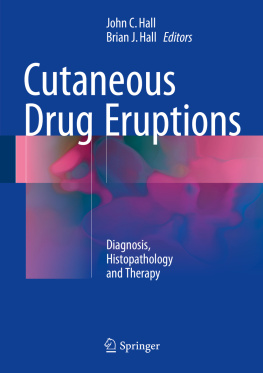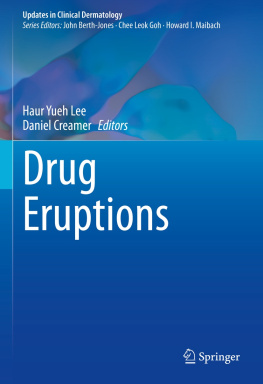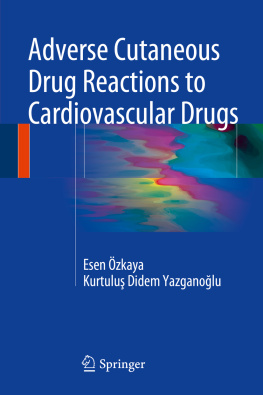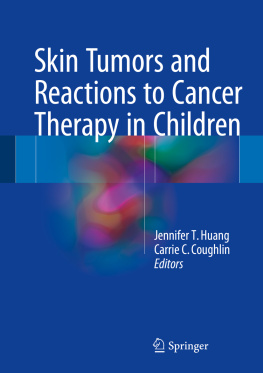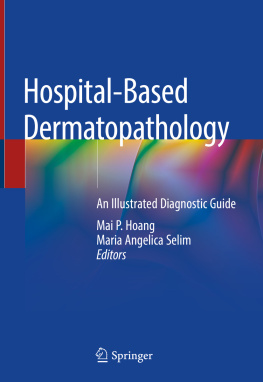Springer-Verlag London 2015
John C. Hall and Brian J. Hall (eds.) Cutaneous Drug Eruptions 10.1007/978-1-4471-6729-7_1
1. Immunology of Cutaneous Drug Eruptions
Abstract
Adverse drug reactions (ADRs) are divided into type A (pharmacotoxicologic) and type B (hypersensitivity) reactions. Type B ADRs represent ~1015 % of all ADRs, and immune-mediated hypersensitivity drug reactions account for ~10 % of type B ADRs. These hypersensitivity reactions are reproducible with repeat drug exposure and occur at drug dosages tolerated by normal patients. The immune mechanisms leading to type B severe cutaneous adverse reactions to drugs (SCARs) are diverse and incompletely understood. Ongoing research is shedding some light on these diverse reaction patterns, but also generating new questions. While the human immune system functions as a seamless syncytium, the intellectual compartmentalization of the immune system into various arms makes it easier to comprehend. Certain of these arms appear to predominate in the various types of SCARs noted clinically.
Adverse drug reactions (ADRs) are divided into type A (pharmacotoxicologic) and type B (hypersensitivity) reactions. Type B ADRs represent ~1015 % of all ADRs, and immune-mediated hypersensitivity drug reactions account for ~10 % of type B ADRs. These hypersensitivity reactions are reproducible with repeat drug exposure and occur at drug dosages tolerated by normal patients. The immune mechanisms leading to type B severe cutaneous adverse reactions to drugs (SCARs) are diverse and incompletely understood. Ongoing research is shedding some light on these diverse reaction patterns, but also generating new questions. While the human immune system functions as a seamless syncytium, the intellectual compartmentalization of the immune system into various arms makes it easier to comprehend. Certain of these arms appear to predominate in the various types of SCARs noted clinically.
Both adaptive and innate aspects of the immune system may contribute to the development of SCARs. The classic Gel and Coombs delineation of delayed type hypersensitivity reactions highlights recognized mechanisms that lead to the development of different SCARs (Table ).
Table 1.1
Gel and Coombs Hypersensitivity reactions
| | Mediator | Mechanism(s) | Clinical phenotypes |
|---|
Type I | Immediate | IgE | Ag binding to mast cell/basophil surface receptors | Urticarial, anaphylaxis, angioedema |
Type II | Antibody-mediated (cytotoxic) | IgM, IgG | Ab binds to Ag leading to complement driven cell lysis or cell-mediated cytotoxicity or recruitment of neutrophils/monocytes | Goodpastures; ANCA vasculitis; drug-induced thrombocytopenia; hemolytic anemia |
Type III | Immune complex | IgM, IgG, IgA | Ag-Ab complexes deposit in tissue trigger recruitment of leukocytes and activation | Serum sickness reaction; Henoch-Schnlein purpura |
Type IV | Delayed-type | T-lymphocytes | Activated T cells produce cytokines causing inflammation leading to tissue effects or directly attack cells |
Type IVa Monocytic | Th1 CD4+: IFN-, TNF | IFN- stimulated KC and MC cytokine production | Allergic contact dermatitis |
Type IVb Eosinophilic | Th2 CD4+: IL-4, IL-5, IL-13 | Th2 cytokines and eotaxin recruit eosinophils | DIHS |
Type IVc Cytotoxic T cells | Cytotoxic CD8+ or CD4+ T cells: IFN-; TNF | Activated cytotoxic T cells induce KC lysis | SJS/TEN |
Type IVd Neutrophilic | Th17 CD4+: IL-17, IL-22, IL-8 | Th17 cell derived IL-17/IL-22 stimulate KC secretion of IL-8 leading to neutrophil recruitment | AGEP |
Genetic factors have long been recognized to have a strong contributory role, and with improvements in genetic analysis, the mechanisms by which specific inherited polymorphisms contribute to specific SCARs are being clarified. This has led to the development of the fields of pharmacogenetics and pharmacogenomics. Further elucidation of these mechanisms may lead to the development of pharmacoepigenomics/pharmacoepigenetics as better understanding of the effect of environmental factors on the genome leading to predisposition or resistance to SCARs is understood. Genetic factors influence the development of SCARs in a variety of ways. Inherited variations in drug-metabolizing enzymes may increase the production of immunogenic drug metabolites (variable metabolism by variants of cytochrome p450 enzymes or altered drug processing by variations in epoxide hydrolase). Additionally, specific haplotypes of human leukocyte antigen (HLA), which play a primary role in T cell stimulation, have long been recognized to contribute to increased risk of SCARs.
Genetic factors, drug pharmacology, and immune responses interact in complex fashions to create the potential for SCARs. Better understanding of these interactions and how they lead to SCARs will lead not only to improved therapeutic interventions, but also allow pharmacogenomic testing to preemptively assess patients for risk of reactions to specific drugs.
Models of Drug Allergy Development
Several models exist to explain how MHC-dependent T-cell stimulation by drugs develops, triggering the immune responses that leads to SCARs.
The classic hapten/prohapten model proposes that a small neutral molecule becomes immunogenic upon binding to a protein. There are various mechanisms by which this could develop; a small molecule binding to a high molecular weight protein then becomes immunogenic. Prohapten molecules can become immunogenic after metabolism to intermediates that are reactive and can then bind to proteins. This allows presentation via HLA molecules to T cells and development of an immune response. After re-exposure, memory T cells proliferate, triggering an inflammatory response over 2472 h.
A second mechanism is the hapten independent ( p-i model ) where direct interaction of the drug with immune receptors occurs without a prior sensitization phase. The interaction is directly with T cell receptors or MHC molecules and can explain how some drugs trigger T cell activation without prior exposure. A final concept, the altered peptide repertoire model , suggests that an altered milieu of self-peptides is presented to or recognized by T cells due to drug binding in the antigen-binding cleft of certain HLA molecules thus triggering the immune response. This is exemplified by abacavir, which appears to non-covalently bind in the F-pocket of HLA-B*5701 altering the shape of the cleft and the peptides that bind it.

